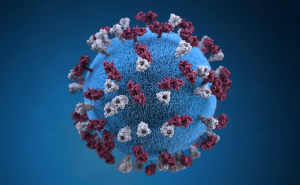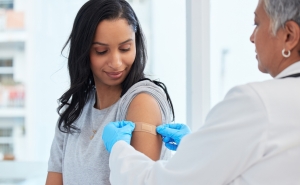Where We Are in the Pandemic

While high COVID case numbers remain a cause for concern, increased population immunity from vaccination and infection means that a smaller share of infected people end up in the hospital.
A year from now, says infectious disease epidemiologist David Dowdy, it’s possible that today’s “mild” COVID could be what we consider the most serious result.
In this Q&A, adapted from the May 24 episode of Public Health On Call, Lindsay Smith Rogers talks with Dowdy, MD, PhD ’08, ScM ’02, an associate professor in Epidemiology, about the changing landscape of COVID-19, how immunity is evolving within it, and why “mild” COVID still matters.
There are reports that vaccinated people made up 42% of fatalities in January and February during omicron. That’s compared with 23% at the peak of the delta wave. What’s going on here?
What’s going on is that people who are not vaccinated are building up immunity by getting sick. What we’re seeing is that being vaccinated or getting sick does not provide perfect protection, or even long-lasting protection against getting ill again. We’re probably going to see a larger fraction of people who get COVID being those who are vaccinated.
The flip side is that the vaccines are still really effective against serious illness and hospitalization. For example, recent data from New York State suggests that people who are vaccinated are 20 times less likely to be hospitalized. Vaccines aren’t going to protect you forever against getting sick, but they will protect you from getting really sick.
Does this have anything to do with omicron itself? Or does it have more to do with the lifting of nonpharmaceutical interventions like masks?
Honestly, probably neither of those. It’s probably more that the unvaccinated are more likely to have gotten COVID and therefore built up immunity through infection. There’s a component of this being a new variant and a component of changes in behavior, though nonpharmaceutical interventions haven’t been all that strong for the past year or so.
What do we know about immunity from omicron versus, say, from a booster?
I always hesitate to compare the immunity from a vaccine to an infection, because we know that both types of immunity work. The thing about getting infected is that you don’t know what dose you’re getting, or how sick you’re going to get. You’re kind of rolling the dice, whereas if you’re getting a booster, you know the dose you’re going to get. You might feel under the weather for a day or two, but the vaccines are exceptionally safe.
What we do know is that immunity does build up, whether it’s through vaccinations and boosters or infection. But, the immunity that builds up is immunity against getting really sick, not immunity against getting infected again in the future.
I recently got over COVID. Even what we call a “mild case” can still be pretty disruptive. It feels bleak that our best hope may be to not be hospitalized or get long COVID. Is this just where we are right now?
Yes and no. I think the big picture perspective is that what we’re calling mild cases, hopefully, a year from now will be considered serious cases. I think we’re in a reality where people are going to get infected, probably multiple times, because immunity against reinfection is not that strong, even among people who have been vaccinated, boosted, or infected multiple times. But the average case is getting much milder over time.
If you compare what you were experiencing to what the average case of COVID was a year and a half ago, yes, it’s very disruptive, but it’s not what we were experiencing then. A year into the future, the optimistic view would be that COVID is just like the common cold. We’re not there yet, and there’s no guarantee that that’s where we’re going to get, but I would say it’s a distinct possibility. What causes us to get sick is our own immune system reacting to the virus. As our immune system learns this virus over multiple infections, the optimistic take is that it will continue to get milder and milder, to where it is something that the average person would call mild.
I saw a stat from Axios that one in three Americans say the pandemic is over. How does that square with the reality of so much illness right now?
I think the first thing to remember is that COVID-19 is not over and will not be over at least for the foreseeable future. Whether we consider the “pandemic” phase of COVID-19 to be over really depends on what our benchmark or threshold is. With so many people still getting fairly ill, I think it’s a little early to call it over. I would like to see the burden of COVID-19 get down to that of other well-known infections, like the flu, for example, before we call this, you know, this pandemic “over.” When we reach that threshold is going to be a matter of debate, but COVID-19 itself, this disease, is not and will not be over.
Is the hope that a year from now COVID will be endemic and these disruptions will be fewer?
The hope is that, while people will continue to get sick from this virus, it won’t be so disruptive. We have to remember there are hundreds, if not thousands, of different types of viruses that infect human beings, and we’ve been living with these for centuries. Different ones do cause different levels of sickness. The flu makes you feel pretty terrible for a week; many adenoviruses are unnoticeable. I think that ultimately the coronavirus is going to sit somewhere in the middle of those. It’s not going to be something that you don’t notice, but as our immune systems learn about this virus over time, hopefully it won’t be as serious as it is right now.
The immunity that you get when you are infected or when you’re vaccinated against reinfection does last for a number of months, so you’re not going to be getting sick every month over and over again. But this is going to be a virus that we have to live with, and it’s going to be one that most, if not all of us get at some point.
We’d be remiss if we didn’t acknowledge that hospitalizations are going up right now. We just hit a major milestone of 1 million deaths. Where are we at this moment?
Relative to the low point in late March and early April, we’ve seen more than a tripling of cases, whereas hospitalizations have only gone up by about 50%. So, the average case is becoming milder.
What we’re also seeing is a disconnect between people who are older, immunocompromised, and more at risk than the average healthy person as we go forward. For the average person with an intact immune system, this is generally an illness that is disruptive, but manageable. But for those [at higher risk], this is still a very serious illness that can easily land you in the hospital.
If you could look into a crystal ball, what do you think might be coming over the next few months?
I don’t want to suggest that I have a crystal ball, but over the past month, month and a half, we’ve seen a gradual increase in the number of people who have been getting sick with this virus. I think we can expect those trends to continue.
As we’ve seen in the past, we will probably see waves going across the country. Right now we’re seeing more infections in the Northeast, and we’ll probably see that travel to the South and the Midwest and back again. Hopefully, those waves become milder over time. But I think it’s too early to say that’s going to happen, and no one can rule out another big wave in the future.
It’s important for us to realize that we are entering a new phase of this pandemic, but it’s a little too early to call it over. We have to realize that even though the average case of COVID-19 is getting milder, it still is quite disruptive, can lead to longer-term symptoms, and is very much a risk for those who don’t have the same intact immune systems as others. We need to consider those people as we think about how to move forward—because we’re all important members of society.
Lindsay Smith Rogers, MA, is the producer of the Public Health On Call podcast and the associate director of content strategy for the Johns Hopkins Bloomberg School of Public Health.





